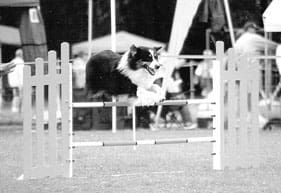Massage is a broad discipline that includes Swedish, Western, and sports massage techniques to name only a few. This series on canine massage will discuss several methodologies, but will begin by describing one of the basic Swedish massage movements and its physiological effects and benefits. Swedish massage has its origins in a system devised by Pehr Henrik Ling, a Swedish physiologist and gymnastics instructor who is considered the father of Swedish massage and also the father of physical therapy. Johann Mezger, a Dutch physician, promoted Swedish massage and is given credit for the French names of many of the movements. The five basic Swedish massage strokes are effleurage, petrissage, friction, tapotement, and vibration.
Effleurage (ef-flur-ahzh), the first massage movement we will consider, is probably the most frequently used of the Swedish massage strokes. It is a very basic and useful massage tool whether the intent is to relax, reduce stress, or rehabilitate. The name comes from the French word, effleurer, which means to “flow or glide” or “skim the surface.”
Physiological effects: Nourishing the tissues
Effluerage strokes have very positive effects on the body. A basic understanding of the working of the circulatory and lymph systems clarifies why effleurage is such a powerful tool.
Blood is pumped out of the heart in arteries, which, in general carry freshly oxygenated blood to the body tissues. The force of the pumping creates pressure in the arteries that helps move the blood through the vessels. The arteries branch into smaller and smaller vessels and eventually are reduced to tiny capillaries each with a diameter so small that the red blood cells must pass through in single file! It is from these capillaries that oxygen and nutrients can efficiently leave the blood stream to supply muscle, nerve, and other body cells.
After oxygen and nutrients have left the capillary network to nourish tissues, the tiny vessels pick up carbon dioxide and waste products such as lactic acid. The capillaries empty into venules, the smallest vessels in the system of veins that carry the blood back to the heart. The blood pressure in the veins is much reduced after passing through the capillary network. And the less muscular veins must rely on the contraction of surrounding skeletal muscles to literally squeeze the veins and push the blood along.
Veins have a series of valves that open as blood is forced through by the contracting skeletal muscles. Then the valves close to keep the blood from moving back in the wrong direction.
Interspersed in the capillary beds are the beginnings of tiny lymph vessels that play a major role in picking up excess fluid from between cells. These small vessels empty into larger and larger vessels that eventually dump their contents into veins, thus returning the materials to the circulatory system. Lymph vessels are similar to veins and have thin walls and a system of valves.
Go with the flow
Effleurage is always performed in the direction of the venous blood flow (toward the heart) to aid the movement of blood and lymph in the correct direction and to prevent damaging delicate vessel valves.
Varicose veins are simply veins in which valves have been damaged and cannot close tightly. Because the blood is not efficiently moved toward the heart, it pools, stretching the veins. Many veins lie very close to the surface and massage must be performed with this in mind. Effleurage against the direction of venous blood flow can potentially damage valves and create a similar problem.
This explains why effleurage of the limbs is performed from the knee toward the hip and from the toes toward the knee. This may feel unusual as hands move opposite to the direction that the dog’s hair grows, but it is important to maintain healthy vessels in the circulatory and lymph systems and to encourage the removal of wastes, toxins, and excess fluid from the region.
It is easy to see that even light to moderate pressure with effleurage warms the underlying tissues and can cause the arteries to dilate, increasing blood flow and bringing more oxygen and nutrients to the area. At the same time, moving in the direction of venous blood flow, the massage removes wastes and toxins and refreshes the tissues. Effleurage also helps dissipate swelling by promoting the movement of extracellular or interstitial fluid out of the region. In addition, effleurage has a soothing effect on the nervous system that facilitates relaxation and fosters a sense of well-being in the dog. So this Swedish massage stroke that appears so gentle, can in fact have very important health benefits.
An effleurage session
Before beginning any massage, it is important to consider why you will be massaging the dog. In other words, you need to establish your intent for the session. It may be to relax your canine friend, decrease stress, reduce swelling in some area, increase the range of motion in a specific joint or joints, or some other purpose. In any case, your overall intent should be to interact for the good of the animal. It is important to set the goal of the massage in your mind and to communicate your intent to the animal verbally or with positive images in your mind. After introducing yourself and establishing your intent, it is time to begin.
Effluerage resembles petting your dog and is sometimes referred to as petting with a purpose. Use an open hand or some part of it to glide over the surface of the coat, always moving toward the heart or in the direction of the venous blood flow (the blood returning to the heart).
The size of the dog or part of the dog you wish to address will determine the amount of contact you make with your hand. The entire palmar surface of the hand can be molded to fit the musculature of a large dog or even larger areas of a small dog. Smaller areas or smaller dogs may require that you effleurage with only one or a few fingers. Pressure should be light over thinly-muscled, bony areas such as the face, head, and legs, and moderate over large fleshy muscles.
The move can be performed with one or both hands. One-handed effleurage truly resembles a petting motion. Slowly glide one hand over the surface to be effleuraged. Your goal is generally to warm the tissues and increase circulation so movements should be slow and deliberate. Always keep the second hand in contact with the dog even if it is not actively being used in the massage stroke. This maintains a constant communication with the dog and keeps you aware of his body. For example, you immediately know if his muscles are relaxing or tensing.
Two-handed effleurage is performed by alternately stroking with one hand and then the other. As one hand is being lifted off of the dog, the second hand should be starting its stroke. Always have one hand in contact with the dog. The movements should be smooth and in a straight line. Obviously, two-handed effleurage is used most efficiently over larger areas.
Legged up
Special attention must be paid to the legs. Veins are very close to the surface and care must be taken to work with them and not against them. As noted above, you should always work in the direction of the venous blood flow. This means that the direction of the effleurage stroke is up the leg or from the toes toward the hip. One may effleurage the larger thigh muscles from knee to hip and the less fleshy part of the leg from toes to knee. When massaging from toe to knee, you may wish to lightly place one hand on either side of the leg and move up. The leg of a small dog can be encircled with fingers and thumb and effleuraged. Remember that the vessels are very near the surface, so use light pressure.
This is an excellent stroke to aid in reducing swelling in an elbow, knee, or hock, but remember to consult your veterinarian first for approval to massage a dog with a swollen joint. Never massage directly over a swollen region. Work below the swollen joint and above it with gentle effleurage. This will mechanically aid the veins and lymph vessels in the removal of excess waste materials and fluid from between the cells (interstitial fluid).
Effleurage is a powerful massage tool for puppies to seniors and all ages in between. Use it often to relax, promote a healthy coat and body, and to intensify the bond between you and your canine friend.
Also With This Article
Click here to view “Mastering Canine Massage Skills”
Click here to view “Canine Massage Therapy”
-By C. Sue Furman
Author Sue Furman is an Associate Professor in the Department of Anatomy and Neurobiology at Colorado State University in Ft. Collins, CO. She is also active as a free-lance writer and teaches equine and canine massage classes. This article is adapted from material in her new book, Canine Massage, that will be available in spring 2000.






